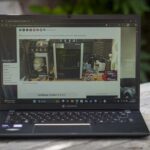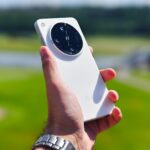Why you can trust TechRadar
We spend hours testing every product or service we review, so you can be sure you’re buying the best. Find out more about how we test.
Thermal Master P3: 30-second review
Thermal imaging has come a long way from bulky, industrial-grade gear to sleek, smartphone-powered tools. The Thermal Master P3 is a prime example of that evolution. Building on the success of its predecessors, particularly the ultra-compact P2 Pro, the P3 refines the formula with sharper resolution, manual focus, and a more tactile, professional-grade build. It’s a device that doesn’t just fit in your pocket; it earns its place in your toolkit.
At its core, the P3 is a plug-in thermal camera designed for Android and iOS devices, offering a native 256×192 infrared resolution that can be digitally enhanced to 512×384 using the brand’s X³ IR software. That’s a notable leap from the P2 Pro’s fixed-focus setup, which, while impressively portable, lacked the precision needed for close-up diagnostics. The addition of manual focus and a macro lens transforms the P3 into a serious contender for professionals who need more than just a thermal snapshot.
The build quality also marks a shift in tone. Where the P2 Pro leaned into minimalism with its featherweight plastic shell, the P3 opts for an aerospace alloy body that feels solid and premium without sacrificing portability. It’s still light enough to carry anywhere, but now rugged enough to survive the kind of environments where thermal imaging is most useful.
So who’s this for? The P3 is ideal for engineers, HVAC technicians, electricians, and anyone working in diagnostics or maintenance. It’s particularly well-suited to electronics professionals who need to spot micro-heating anomalies on PCBs, thanks to its macro lens and manual focus. It’s also a smart pick for field inspectors who want a reliable thermal tool without the bulk or battery anxiety of standalone imagers.
In short, the Thermal Master P3 isn’t just an upgrade — it’s an evolutionary step. It takes the portability of the P2 Pro and adds the kind of precision and build quality that professionals demand. If you’ve been waiting for a thermal camera that’s as serious about detail as you are, the P3 might be the one to beat.
Thermal Master P3: price and availability
- How much does it cost? $299/£299/€299
- When is it out? It is available now
- Where can you get it? You can get it in most regions from an online reseller and directly from Thermal Master.
Thermal Master P3 offers one of the best balances of resolution, manual focus, and build quality at the $299 mark. It’s available direct from the Thermal Master official site here.
At that price, it is comfortably below flagship models like the FLIR One Pro, yet offers superior thermal resolution and control. While it lacks a visible light overlay and requires sideloading on Android, these trade-offs are minor compared to the imaging clarity and build quality it provides.
It can be bought on Amazon.com, but the price there is the MSRP of $349.
The Thermal Master P2 Pro is cheaper and more portable, but the lack of manual focus makes it less suitable for detailed inspections.
I’d position the P3 as a mid-range powerhouse that punches above its weight in precision and build quality, especially for professionals in electronics and HVAC.
Thermal Master P3: Specs
|
Feature |
Specification |
|---|---|
|
Model |
Thermal Master P3 |
|
Infrared Sensor |
RazorX? IQ+ |
|
IR Resolution |
256×192 (native), 512×384 (via X³ IR? upscaling) |
|
Temperature Range |
-20°C to 600°C |
|
Accuracy |
±2°C or ±2% (whichever is greater) |
|
NETD (Sensitivity) |
Estimated |
|
Focal Length |
4.3 mm |
|
Focus Type |
Manual focus + macro lens |
|
Digital Zoom |
Up to 15× |
|
Frame Rate |
|
|
Image Enhancement |
X³ IR™ software upscaling |
|
Colour Palettes |
12 options (e.g. whitehot, ironred, red hot) |
|
Compatibility |
Android (USB-C), iOS (Lightning/USB-C), Windows PC |
|
App Availability |
iOS App Store; Android via sideload |
|
Body Material |
Aerospace alloy |
|
Dimensions |
59 × 27 × 17.2 mm |
|
Weight |
26.3g |
|
Power Consumption |
Low (powered via phone connection) |
|
Use Cases |
PCB inspection, HVAC, automotive, pipelines |
Thermal Master P3: Design
- Tiny camera
- PC and phone
- 50mK NETD
If cuteness played a part in this evaluation, then the P3 would score highly.
This tiny camera measures just 59mm across, is 27mm high, and only 17.2mm thick, with most of that thickness being the length of the lens.
There is only a single control on it, that being the twisting lens to focus, everything else is done from the phone or PC app.
What’s less endearing is that the thermal sensor is exposed, as Thermal Master didn’t include a lens cap for this device. What you do get is a soft carry case that includes a short 27mm adapter to use it with an Apple Lightning connector.
Included in the box is a longer, 45cm cable that connects the P3 to a PC using either USB-C or USB-A. Disappointingly, those at Thermal Master responsible for creating the soft carry case weren’t informed about this cable, and it won’t fit with the camera in the case.
That’s annoying, and another consideration is that using it with a Laptop or desktop PC means there’s no tripod or other way to position it without holding the camera.
If you are using this device to analyse a motherboard for hot spots, you’ll need to rig something temporary up, or print your own mounting system with a 3D printer.
Those using it with a phone might also have issues, since the USB-C blade on the camera is deeper than some phone ports, causing a gap between the two. Obviously, since it’s USB-C, it is possible to put the camera in either facing the user or away, but as it’s necessary to see the screen, away is the most useful.
When it’s inserted, the P3 draws power from the phone or PC, which might reduce battery life if the exercise is a prolonged one.
In terms of the thermal technology in this camera, the P3 uses the same RazorX IQ+ sensor that Thermal Master used in the P2 Pro. Its native resolution is 256×192, but on this device, Thermal Master has implemented X³ IR upscaling to deliver 512×384 by combining the data from multiple passes.
That’s much better than the 160×200 offered by the FLIR Lepton 3.5 sensor, and the sensitivity is similar. These sensors are rated by NETD, defined as the smallest temperature difference a thermal sensor can detect before the signal becomes indistinguishable from noise. Typically, it’s measured in millikelvin (mK), and the RazorX IQ+ is rated as better than 50mK. The best devices are <25mK, good are <50mK, and some less desirable choices can only register 70mK.
The other vital specification for this sensor is its temperature range, which is -20°C to 600°C, with an accuracy of plus or minus 2°C. That probably makes it unsuitable for those forging metals that have high melting points, but it’s fine for heating systems and vehicle repairs.
Design score: 4/5
Thermal Master P3: User experience
- Android and iOS
- Good quality captures
- Limited PC connection
While it does work with a PC, the P3 was made with smartphone users in mind.
For those using an Apple phone, on the iPhone 15 and newer models, a Lightning Port or USB-C is required. The P3 includes a USB-C to Lightning adapter for older models. The device should run on iOS version 13 or higher to ensure app compatibility and feature support. Additionally, the device should be an iPhone 7 or newer, as older models may struggle with resolution upscaling and frame rate.
For Android users, ensuring compatibility with the P3 app and stable performance, a device must have a USB-C port for direct connection and OTG (On-The-Go) support enabled. The device should run on Android version 8.0 or higher. A Snapdragon 660 or equivalent processor and above is recommended for smooth image rendering and upscaling. Additionally, the device should have at least 3GB of RAM to handle high-resolution thermal data and ensure app responsiveness.
I’ll talk about performance later, but the first significant irritation of this platform is that for Android users, the app must be downloaded and then sideloaded. Why it isn’t on the Google Play Store is a mystery, since the iOS version is on Apple’s store.
This isn’t a straightforward exercise for an average Android user, as it involves configuring the phone to accept sideloaded apps, and then finding the right version on the Thermal Master website. The file actually comes via Dropbox, and for some inexplicable reason “.1” was added to the file extension, meaning that Android phones won’t identify this as an app.
To install the app, it needs to be renamed to the “.apk” extension.
Did anyone at Thermal Master test this? It’s just a magnet for support calls in its current form.
Once installed, the app correctly identified the P3, but confusingly, the app is called the Thermal Master P2 app. I presume this is because this app was written for the P2 Pro, and the developers assumed it would never be used with any other hardware.
That said, it did enable the X³ IR upscaling on the P3, a feature missing from the P2 Pro.
This multi-pass mode generates better resolution images, but it significantly reduces the framerate, regardless of the phone’s power. That makes it harder to use, unfortunately.
I suspect that the real issue here is that USB-C ports on Android devices are normally USB 2.0, and the amount of data that needs to flow back probably hits the transfer speed limits.
But whatever the reason, if high-quality images are required, then it’s something you may be forced to work around. For thermal images, the results are good, better than the Thor002 I recently reviewed.
However, there is a missing piece to this puzzle that phones with inbuilt sensors can do, but this system doesn’t offer. Phones with a thermal camera in their sensor often have a mode that captures a conventional light image with a thermal one. These are either stored alongside each other or combined to form a hybrid image.
The P3 software doesn’t offer the hybrid option to use the phone camera to show the location in conventional light, but it does have a picture-in-picture option. In this mode, it captures a smaller version of the rear camera image and floats it above the thermal image. The problem here is that the zoom levels between the two images are massively different, and while you can zoom the P3 sensor, there is no control over the normal light camera.
It also doesn’t work if you have the P3 inserted to look forward, and it doesn’t save both images individually when you snap a shot.
Images are saved at 1440 x 1080, which is at least a proper ratio of the natural 256 x 192 sensor. They both have a 1.33 ratio, which is an improvement over the Thor002 captures, which were stretched by arbitrary numbers.
For those wondering, the capture resolution appears to be unrelated to the screen of the capture phone, since in my tests I used the Oukitel WP210, and that has the curious resolution of 1080 x 2412.
Overall, this is an excellent thermal camera. My only reservation about it is that to use the X³ IR upscaling seems to require an inordinate amount of processing power, slowing updates markedly. That’s even on a relatively powerful phone.
I suspect that GPU acceleration in many SoCs could make its use less demanding if Thermal Master recoded the application to make better use of those chips.
A word of warning. If you get one of these and use it with a phone, don’t forget to remove it after use, as the power consumption of the camera will drain the battery if you leave it connected.
The PC application is exclusively on Windows, and it defaults to Chinese on installation, so you will need to alter that to English if, like me, you don’t speak that language.
Interestingly, the PC tool is a cut-down version of the phone application, missing some of the more exotic features. There is no X³ IR upscaling toggle, as it appears to be active all the time, and supporting that assertion, the output of captured files is 512 x 384 resolution.
The big issue I encountered with the PC software is that the camera is on the USB cable, so it needs to be held by the user all the time. After a very short time, this becomes exceedingly frustrating, since manually focusing something you are holding is a fraught exercise. On the PC, this hardware so badly needs a tripod or at least something that enables the camera to be mounted.
That there is no Apple Mac OS or Linux tool is disappointing for those who use those platforms. There also isn’t a ChromeOS app, but it might be possible to use the Android software in that context.
Overall, the software could be better, but it works.
- User experience score: 3.5/5
Thermal Master P3 Camera samples
Thermal Master P3: Final verdict
This product is tantalisingly close to being brilliant, but it needs a stand/tripod/mount, and the software needs refinement. Undoubtedly, the part that Thermal Master nailed was the hardware of the camera, which could only be bettered with software-controllable focus.
Overall, the P3 is a significant improvement over the P2, and the best add-on thermal solution I’ve seen so far.
If Thermal Master could come up with a tripod, it would stand head and shoulders above the competitor offerings.
Should I buy a Thermal Master P3?
|
Attributes |
Notes |
Rating |
|---|---|---|
|
Value |
High quality at a reasonable price |
4/5 |
|
Design |
Highly engineered and portable |
4/5 |
|
User experience |
Needs a tripod and improved software |
3.5/5 |
|
Overall |
Excellent quality and easy to carry |
4/5 |
Buy it if…
Don’t buy it if…
Also Consider
Read the full article here














